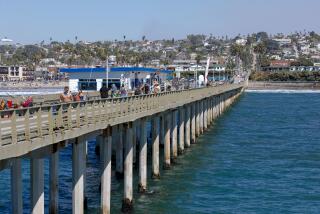State Panel OKs Dismantling of Artificial Island
Despite eloquent pleas from sport fishermen and divers, the California State Lands Commission on Friday approved the dismantling of artificial Belmont Island off Seal Beach and relocation of its rock base to an artificial reef off Huntington Beach.
Opponents had argued that the former oil production facility provides a reef-like habitat to scores of sea creatures.
“I’m saddened to see the political process does not put together the science needed to see . . . what’s going on in the marine environment,” Milt Shedd, a founder of Sea World-San Diego, told commission members meeting in Los Angeles. “Resources the world over are being destroyed because we manage resources by the seat of our pants.”
Controversy has been brewing for months over the island, which was built about 1 1/2 miles offshore in 1954. Oil production ceased there in 1995.
Shedd was one of several sport fishermen and divers who urged officials to do more research into leaving in place the riprap, or rocks, that surround the island’s concrete support. Their contention that the island is teeming with invertebrates and fish added fuel to a heated debate raging in Sacramento about what to do with obsolete oil rigs.
But water quality, navigation and liability concerns prompted the commission to approve plans by ExxonMobil Corp., which owns the island, to dismantle it and haul the riprap to the state’s Bolsa Chica Artificial Reef about four miles off Huntington Beach--a decision that some activists said is too hasty.
“It’s a shame to remove the island before doing more research to find out what we’re destroying,” said Tom Raftican, president of United Anglers of Southern California. “It’s got tremendous value for not just recreational fishing but for the entire marine environment.”
According to a July study, the ecosystem supported by the island’s riprap is diverse, including abundant gorgonian coral, mussels, short-spined sea stars, rock scallops, tube-building mollusks, barred sand bass and black croaker.
That system, though, “is not necessarily unique,” said Jeff Planck, a senior engineer with the lands commission.
The shelter offered by the island equals less than 1% of the total near-shore habitat available within a 1 1/2-mile radius of the site, he said.
Most of the island has to go because of U.S. Coast Guard concerns about navigation safety. The island is close to the Seal Beach Naval Weapons Station and just south of the entrance to Long Beach Harbor.
Water quality near the island has been compromised by the discharge of the San Gabriel River into the Pacific Ocean, making kelp survival there questionable.
But the greatest obstacle is that no public or private body has offered to assume liability for boating or diving accidents if the riprap were left in place, Planck said.
Now, pending California Coastal Commission approval, the 16,000 tons of quarry rock will be moved to the Bolsa Chica Artificial Reef, which is managed by the state Department of Fish and Game. The entire cost of the dismantling project, $25 million to $30 million, will be borne by ExxonMobil.
Dave Parker, a senior biologist with the fish and game agency, said the rock will add significant habitat to the 220-acre artificial reef. Such a large quantity of rock would typically cost the agency about $1 million, he said.
The Belmont Island issue is part of a larger debate over the controversial “rigs-to-reefs” proposal being considered by the Legislature.
Under current state and federal law, decommissioned oil rigs must be removed entirely, the wells must be capped and the sea floor restored to its natural condition. Rigs-to-reefs proponents say the thriving underwater communities found on the rigs’ Tinker Toy-like supports should not be disturbed.
State Sen. Dede Alpert (D-Coronado) has sponsored a bill that would allow oil companies to leave parts of the rigs’ underwater steel structures in place, even after the platforms are removed. Oil companies would save millions in decommissioning costs but would still have to pay a substantial sum--perhaps 75% of the savings--into a marine research endowment fund.
The California Endowment for Marine Preservation bill is scheduled to come before the Senate Natural Resources and Wildlife Committee on Jan. 11.
More to Read
Sign up for Essential California
The most important California stories and recommendations in your inbox every morning.
You may occasionally receive promotional content from the Los Angeles Times.











